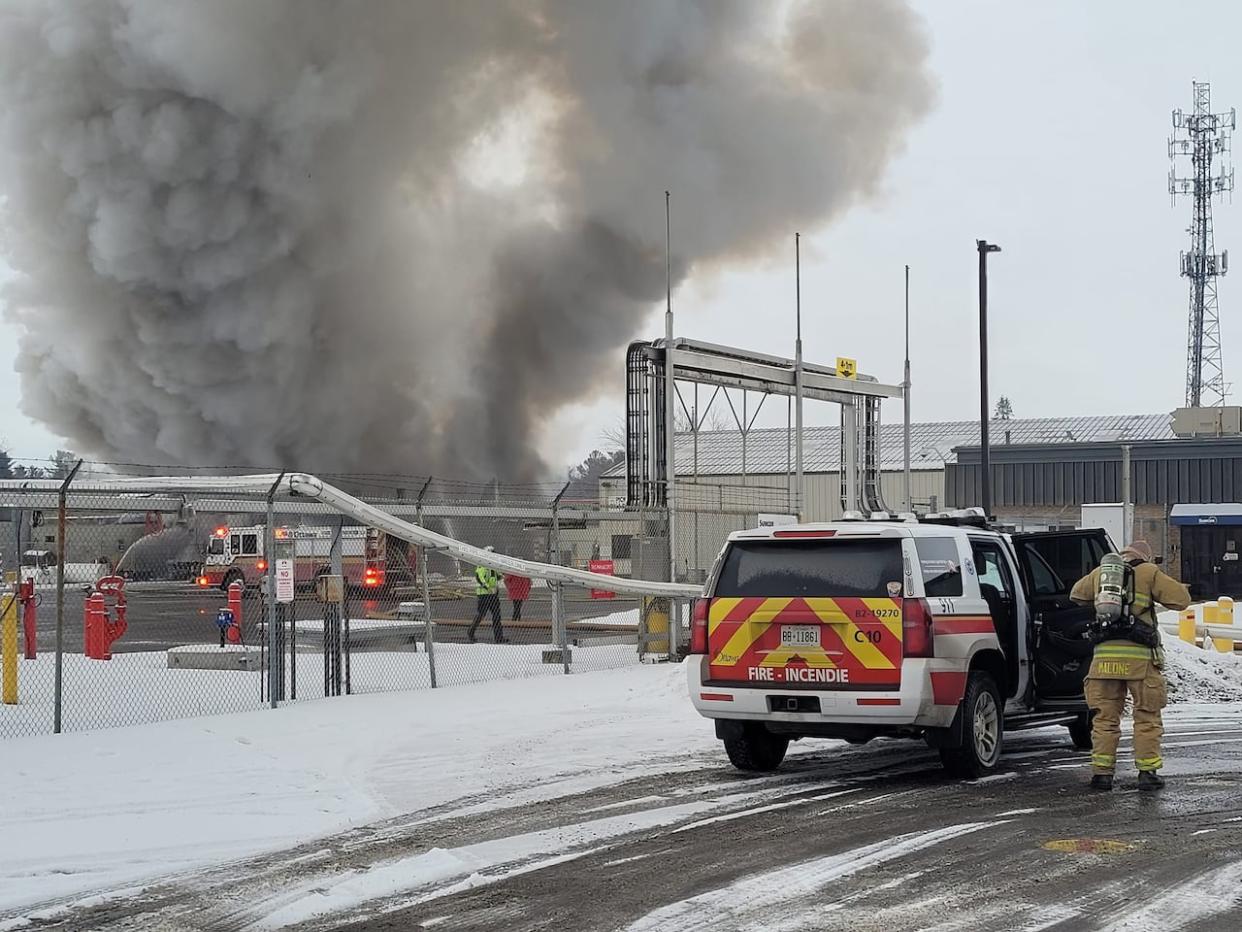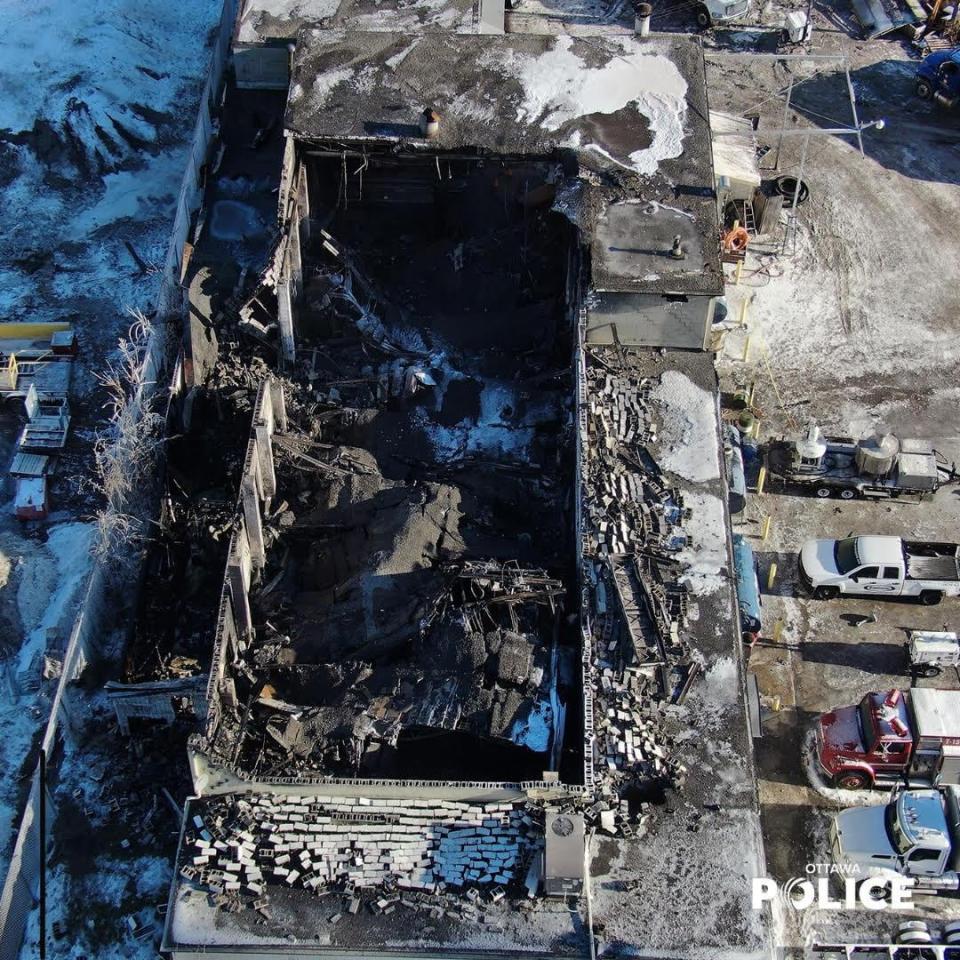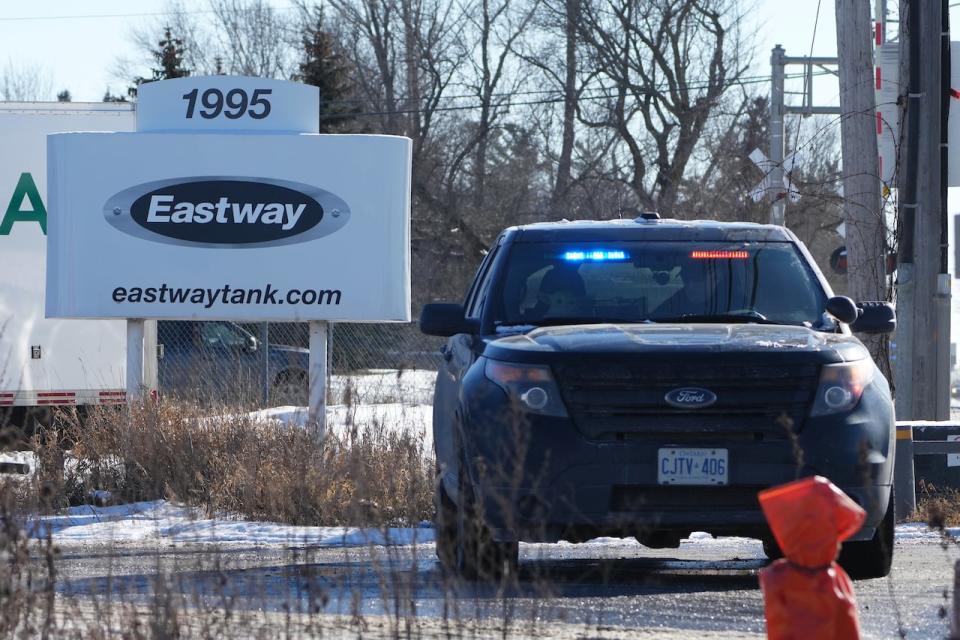Court docs shed light on Eastway Tank disaster — but mysteries remain


Smoke billowed from the Eastway site on Jan. 13, 2022 as crews tried to battle the raging fire following multiple explosions. (David McEvoy/Bytown Fire Brigade )
New details emerged about the likely cause of a fatal explosion and fire at Eastway Tank, Pump and Meter more than two years ago when the company and its owner pleaded guilty to breaching Ontario's Occupational Health and Safety Act.
On Friday, Justice Mitch Hoffman imposed $850,000 in fines and fees — the highest in Ontario's history for a company of that size — on Eastway and its owner Neil Greene for the January 2022 deaths of six employees.
Rick Bastien, Etienne Mabiala, Danny Beale, Kayla Ferguson and Russell McLellan all died in the blast.
Matt Kearney died in hospital the next day, while a seventh employee, Tanner Clement, was severely injured.
The court documents outline some of what happened that fateful day — although some elements, like what caused flammable vapours to ignite, remain a mystery.
The incident
According to an agreed statement of fact, on Jan. 13, 2022, workers had been conducting a "wet test" in the fabrication shop on a new tanker truck that was having fuel put into its tank for the first time.
Wet tests are done to check a tank for leaks and to calibrate the equipment inside. The statement said they'd been performed at Eastway dozens of times a year for decades, both inside the shop and outside.
Between about 1:20 and 1:30 p.m. that day, flammable vapours near one of two tanker trucks in the shop ignited and exploded.
Seconds later, there was an even bigger explosion that caused the roof to collapse, killing Bastien, Ferguson, Beale, Mabiala and McLellan.
Meanwhile, Kearney and Clement were near the front entrance of the shop and "caught fire following the explosion," the statement of fact said.
By 1:31 p.m., fire crews had arrived on scene. Three Eastway employees, including Clement and Kearney, were rushed to hospital.
It took seven and a half hours for crews to get the fire under control.

A drone image of the Eastway site taken by Ottawa police after the explosions and fire. (Ottawa Police Service)
How did it happen?
In a report completed last November, the Office of the Fire Marshal (OFM) outlined how it believed gasoline vapours had developed "in or near the tanker compartment [of the truck being tested] above the hatch, or through a leak in the system or from a spill."
It found the diesel fuel used in the wet test had been contaminated with gasoline. The vapours from that gasoline then built up in the shop and were ignited.
According to the statement of fact, the fuel had been contaminated earlier that morning or on Jan. 12, the day before the explosion.
On Jan. 12 an Eastway worker had pumped between 1,500 and 1,600 litres of diesel fuel into a different truck parked outside to test it for leaks.
According to the statement of fact, at some point after that test was completed, more fuel was added — the document does not say by who — and that additional fuel included "highly flammable" gasoline.
Some of the now-contaminated fuel was then pumped into the fabrication shop, the court documents said, to be used for the wet test on the other truck on Jan. 13.
"The use of even very small amounts of gasoline in a wet test would pose fire and explosion hazards," the agreed statement of fact said.
What ultimately caused the vapours to ignite that day remains unknown.
Fire investigators had to piece together what they could from the aftermath of a scene where evidence was destroyed because of the explosions and the resulting fire.

A police cruiser is shown at the entrance to the Eastway Tank company the day after the explosions and fire. (Sean Kilpatrick/The Canadian Press)
'A sad situation'
Wet tests involve loading a tanker with either air or some liquid, according to Chris Revers, plant manager at Jasper Tank, a tanker manufacturing facility in the Edmonton area.
Revers has 23 years experience in the industry. He was not involved in the case, but reviewed the court's agreed statement of fact.
"It's just a sad situation," he told CBC.
While the industry is highly regulated — falling under Transport Canada and its rules around the transportation of dangerous goods — what happened at Eastway shows companies should better manage how they mix their products, Revers said.
According to Revers, while air is great for testing for leaks, it's not so great when trying to calibrate equipment that's both specifically designed not to allow air in and ultimately will have fluid running through its components.
Because Eastway's tankers are used for diesel or gasoline, water can't be used, either.
Water could never be completely removed from all the parts of the tanker, Revers said, and it doesn't mix with diesel or gasoline when it comes to the end goal — having fuel run through a truck, car or other piece of equipment.
Any leftover water could damage the engine, Revers said, and potentially make it expensive to fix.

Chris Revers works at Jasper Tank in Acheson, Alta. (Submitted by Chris Revers)
Revers said the safest way to do a wet test for a truck designed to eventually carry diesel or gasoline would be to first add the diesel to the tank, do the calibrations, remove the diesel and only then add the gasoline.
But contaminating diesel with gasoline "can easily happen if an employee's not paying attention," Revers said.
If gasoline is added when there's still diesel anywhere in the truck, all it takes is someone hitting one of several switches on the truck and the two liquids mix.
"It is possible that's probably what happened," he said. "Or someone noticed they made a mistake and didn't say anything and returned that product back to the storage tank.
"That happens. We're humans. People are afraid to get in trouble."
Diesel and gas don't mix
While diesel has a flash point — the temperature at which a compound's vapours ignite if given an ignition source — that's around 65 C, much higher than normal working conditions. Gasoline's flash point is much lower.
The OFM found that the contaminated fuel that remained in the outdoor truck after the explosion had a flash point "well below the ambient building temperatures in Eastway."
Those ambient temperatures were estimated by a witness to be about 10 C at floor level and 20 C near the ceiling, according to the statement of fact.
Even though investigators couldn't pinpoint exactly what caused the vapours to ignite, the agreed statement of fact suggests there were several possibilities, Revers said.
One involved Eastway employees who were conducting electrical tests and working on a meter, he said.
"Bolts are metallic. Meters are metallic. Maybe we create a spark," Revers said.
While it appeared Eastway had proper policies in place, Revers said accidents can happen if people don't follow them.
"We become complacent in our duties because we've done it so many times, and people cut corners."

